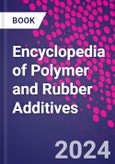Encyclopedia of Polymer and Rubber Additives documents how polymer properties and performance can be improved through the use of additives, resulting in enhanced physical properties, stability, improved process and assembly, extended shelf life, enhanced purity, and minimized environmental impact. 88 groups of additives used by all segments of the polymer and rubber industries are included, with each group discussed in a systematic manner to facilitate easy information retrieval and comparison. Typical chemical structures, mechanisms of action, influences and interferences in complex formulations, and evidence of performance from experimental studies are each featured, with frequent references to monographic sources.
The companion volume, Databook of the Most Important Polymer and Rubber Additives, is also available. It contains robust technical data on the most essential additives currently in use, and the two books are must-have references for anyone working with rubbers and plastics.
Please Note: This is an On Demand product, delivery may take up to 11 working days after payment has been received.
Table of Contents
Introduction to Polymer and Rubber AdditivesAcceleratorsAcid scavengers
Adhesion promoters
Air-release agents
Antibacterial additives
Antiblocking additives
Anticaking agents
Anticratering additives
Antidegradants
Antifriction additives
Antifoaming agents
Antifogging agents
Antifreezing additives
Antigassing additives
Antigelling additives
Antisettling additives
Antistatics
Antitack additives
Biocides
Catalysts
Carbon black
Clarifying agents
Coalescents
Compatibilizers
Crosslinkers
Curatives
Defoaming agents
Dispersing agents
Factice
Fillers
General purpose 2D Conductive Dielectric EMI shielding Fibers
High density Insulating
Magnetic Magnetodielectric
Microwave absorption
Nanoparticles
Osteoconductive Piezoelectric Reinforcement Superlight Flame retardants Flattening additives Flexibilizers
Foaming and blowing agentsGloss enhancing additives
HDT/Vicat enhancers
Hydrolysis stabilizers
Identification additives
Impact modifiers
Insect repellentsLeveling additives
Moisture scavengers
Nucleating agentsOptical brighteners
pH modifiers
PigmentsPlasticizers
Polymerization initiators/inhibition catalysts
Preservatives
Processing aids
Release additives
Rheological additives Antisag agents Inorganic thickeners Melt flow modifiers Lubricants Organic thickeners
Scratch and mar improvement additivesSlip additivesSolventsStabilizers Antioxidants Chelating agents (metal deactivators) HALS Phosphites Thermal stabilizers Acid scavengers Antiozonants Epoxidized compounds Multiketones Quenchers
UV absorbers
Tackifiers
Titanium dioxide
Vulcanizing agents
Water-repelling agentsWetting agents








